Phoenix TV visit (reported by M.A. Journalism student Gao Yiping)
Phoenix TV is targeted at highly-educated intellectual Chinese people whereas CCTV has a mass audience appeal.
This was the opinion of Phoenix TV’s Director of Programme Co-ordination and Deputy Head of Phoenix Chinese Channel, Bobby Wan.
Mr Wan also told a group of post-graduate students of the School of Journalism and Communication of Chinese University of Hong Kong during a visit to its Tai Po new plant in January 2010 that it would be a great challenge for journalism students to work in the media industry because of stiff competition.
“Media must strive to improve its professional standard to give quality service to viewers in order to gain high viewership for advertising revenue in a commercial market,” he said.
In an exchange with students on a wide range of issues related to TV news operations, Mr Wan pointed out that Phoenix TV would always be conscious to provide a quality service in order fortify its professional reputation and branding.
The new head office of Phoenix TV was relocated to a site in the Tai Po Industrial Estate in March 2009.
The visit was led by Director of School of Journalism and Communication, Professor Clement So, and some teaching staff, including Professor Louis Leung and Professional Consultant, David Wong.
The main entrance hall of Phoenix TV is elegantly designed. The idea behind is to echo the logo of Phoenix TV with the main theme “all birds back” welcoming visitors at the reception hall.
Public Relations Manager of Phoenix TV, Charlie Lam, told the visitors that the concept of its design was to highlight the harmony of phoenix in embracing people from countries all over the world.
The centre of attraction is the Global News Centre. The news centre is specially designed to have three circles interlocking into each other. Altogether, nine newsmen can be accommodated into each set of such circular units. Against the digital screen setting, all latest news information, such as stock prices, is flashed across the screen.
The lay out and setting is conducive to a smooth operation for editors and supporting staff to provide back-up to news anchors at any time.
There is also a “lighting system” and red light will flash when emergency arises to alert others.
For regular viewers of Phoenix TV programmes, the corridors and coffee corner are familiar scenes that are featured in its broadcast.
In concluding the visit, Mr Wan said Phoenix TV was prepared to pool more resources on special news coverage that could outperform its rivals. The last presidential election in Taiwan was a good example to underline his view as Phoenix TV could provide the most comprehensive coverage of the presidential election compared with other Mainland news channels despite its relatively limited resources.
When asked whether the editorial position of Phoenix TV was getting closer to CCTV, Mr Wan said CCTV had become more liberal in its news coverage in recent years, thus narrowing the gap between the two.
A strategic move initiated by Phoenix TV is to construct a new building in Beijing next year in order to strengthen its reach and presence in the capital city.
At present, Phoenix TV already has the capability of reaching to all ethnic Chinese on a global level, according to Mr Wan.
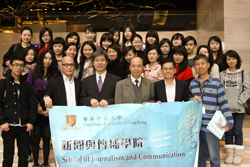

Group photo with Phoenix TV executives (Left)
The Grand Broadcast Centre of Phoenix TV (Right)
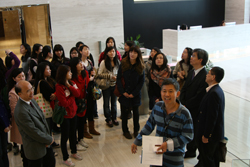
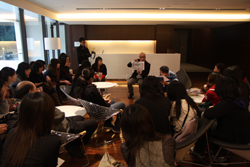
Charlie Lam (middle) explains the design concept of Phoenix TV at reception hall (Left)
Bobby Wan of Phoenix TV briefs students on TV operations. (Right)
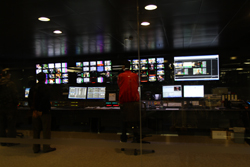
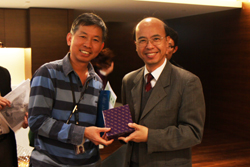
Master Control Panel (Left)
Prof Clement So presents a souvenir to Charlie Lam (Right)
